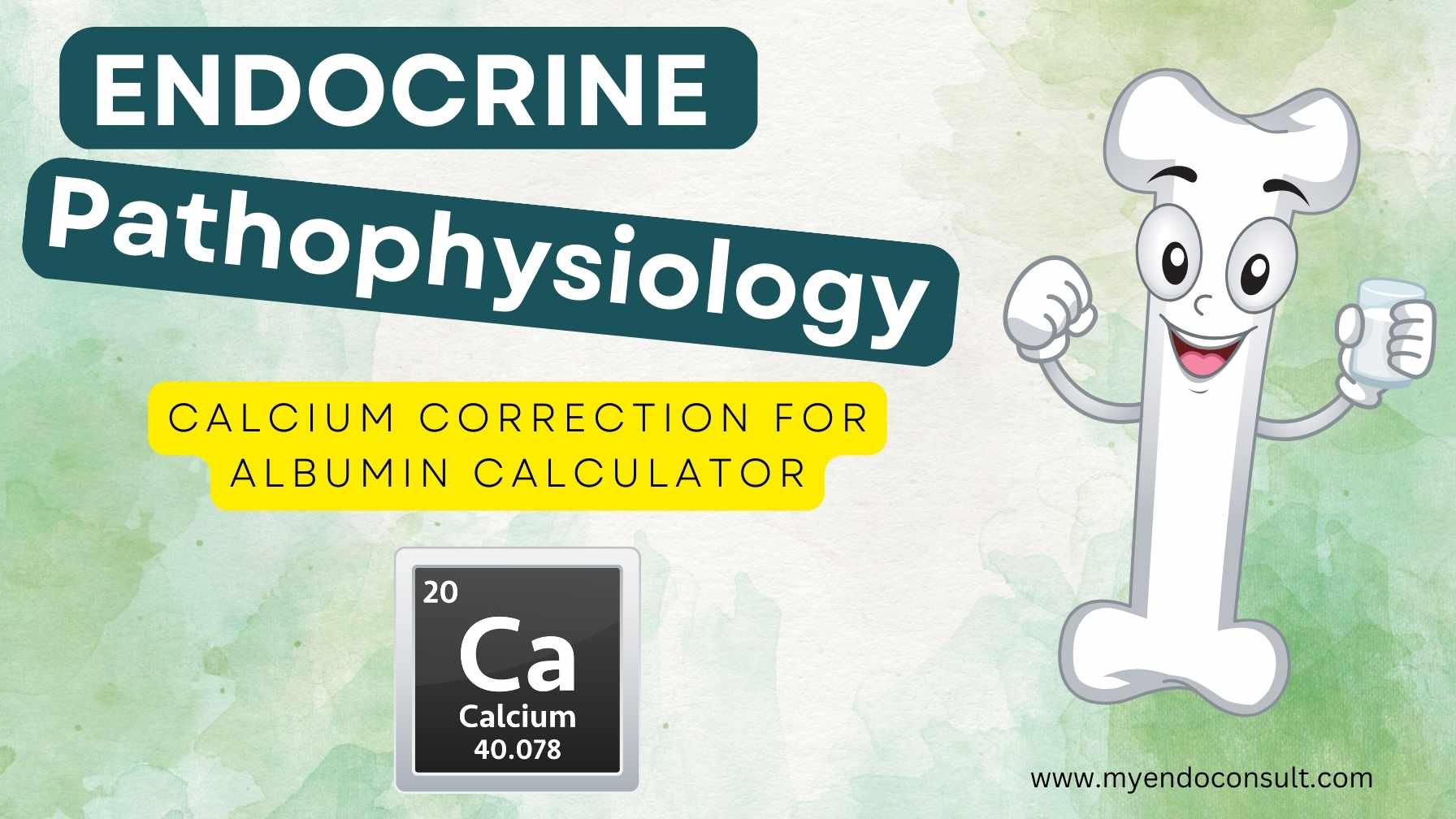
A calculator for estimating serum calcium in patients with hypoalbuminemia. An albumin-adjusted serum calcium is required in patients with abnormally high or low albumin levels.
In mg/dl: Corrected Calcium [mg/dL]: 0.8 x (4g/dL – Patient’s Albumin in g/dL) + Serum Calcium (mg/dL).
In mmol/L: Corrected calcium = 0.02 x (40g/L – Patient’s Albumin in g/L) + Serum Calcium (mmol/L)
The corrected calcium formula may not be effective for people who have chronic or advanced liver disease.
Normal Calcium Levels
Calcium is the most abundant mineral in the human body, with about 99% of it being found in bone1. It is essential in several biochemical processes, including hormone secretion, bone mineralization, maintenance of cell integrity, coagulation of blood, neuromuscular contraction, and signal transduction2,3.
Several hormones with regulatory effects on the parathyroid glands, intestine, bone, and kidneys ensure the maintenance of serum calcium within a narrow physiologic range4,5
Calcium and Albumin Relationship
Approximately 1% of total body calcium is outside the skeletal system. The amount of calcium present in soft tissues and the extracellular fluid compartment is accounted for by this relatively insignificant proportion of total body calcium6. The extracellular fluid compartment is composed of unbound (free) calcium and bound (complexed to albumin and organic molecules) calcium in almost equal proportions. 50% of extracellular calcium is “ionized” and biologically active, 40% remains albumin-bound, and 10% is bound to circulating anions8.
Interestingly the common term for free calcium, i.e., ionized calcium is a misnomer since all calcium in the human bound is ionized. Indeed, “ionized calcium” in plasma or serum exists in a hydrated state and not as free circulating divalent cations6,9
Changes in pH impact the availability of albumin binding sites, which invariably determines the fraction of unbound calcium8,10. Metabolic perturbations in acid-base balance correlate with the levels of ionized calcium.
Metabolic alkalosis causes an increase in circulating bicarbonate which binds ionized calcium. In addition, binding of circulating albumin with calcium increases in the setting of alkalosis. Both reasons account for the low level of ionized or free calcium in the setting of alkalosis10.
The converse occurs in the setting of metabolic acidosis. There is a relatively lower level of circulating bicarbonate; this increases the fraction of ionized or free calcium since less calcium is bound by bicarbonate. Decreased binding of ionized calcium to albumin occurs during metabolic acidosis as well; this is another reason for hypercalcemia in the setting of acidemia10,11.
Calcium correction explained
The body’s total calcium level depends upon serum albumin – the binding protein for calcium. Corrected serum calcium values take into account the level of albumin in the blood.
This is important because albumin levels can fluctuate and cause calcium levels to be inaccurate. Uncorrected serum calcium values do not take albumin into account, which means they may not be as accurate as corrected calcium.
Limitations of corrected total calcium
Ionized calcium is the gold standard for estimating the optimal level of serum calcium. The corrected total calcium equation, a relic of the past, was unfortunately developed at a time when the biochemical estimation of ionized calcium was instead not available for commercial use. Various factors, however, limit the classic corrected total calcium for serum albumin equation.
A significant limitation of corrected total calcium as a means of inferring what ionized calcium should be is that it does not account for variations in hydrogen ions (pH), magnesium, chloride (and other complexing anions), and free fatty acids. It is worth noting that these factors are known to alter the level of ionized calcium.
A critical assumption of the traditional corrected calcium (for albumin) equation is that ionized calcium is relatively stable even at varying albumin levels. However, this assumption is incorrect since ionized calcium and albumin co-vary in normal physiology and critically ill patients [12].
Predictive Models in Special Populations
| Model | Constituent analytes | Population | Web calculator |
| Obi et al [13] | Total calcium Trending Albumin Phosphate | Hemodialysis | Not Available |
| Ramirez-Sandoval et al [14] | Total calcium Albumin Total carbon dioxide Phosphorous | Inpatient setting | Yes (True Calcium App on google play or the App Store for Apple devices) |
| Sakaguchi et al [15] | Total calcium Albumin Sodium Chloride Total carbon dioxide | CKD | Not available |
| Yap et al [16] | Total calcium Albumin Sodium Chloride Total carbon dioxide | Critical Care | Yes |
Acknowledgment
We thank Dr. Philip Goldwasser for his timely suggestions in improving this post. The sections on limitations of corrected calcium and predictive models in special populations were based on his review article, which can be found here.
References
- Ross AC, Taylor CL, Yaktine AL, Valle HBD. Overview of Calcium. National Academies Press (US); 2011. Accessed October 19, 2018.
- Pu F, Chen N, Xue S. Calcium intake, calcium homeostasis and health. Food Sci Hum Wellness. 2016;5(1):8-16.
- Bagur R, Hajnóczky G. Intracellular Ca2+ sensing: role in calcium homeostasis and signaling. Mol Cell. 2017;66(6):780-788.
- Greco DS. Endocrine Causes of Calcium Disorders. Top Companion Anim Med Phila. 2012;27(4):150-155.
- Allgrove J. Physiology of Calcium, Phosphate, Magnesium and Vitamin D. Calcium Bone Disord Child Adolesc. 2015;28:7-32.
- Baird GS. Ionized calcium. Clin Chim Acta Int J Clin Chem. 2011;412(9-10):696-701. doi:10.1016/j.cca.2011.01.004
- Calvi LM, Bushinsky DA. When Is It Appropriate to Order an Ionized Calcium? J Am Soc Nephrol. 2008;19(7):1257-1260.
- Bushinsky DA, Monk RD. Calcium. The Lancet. 1998;352(9124):306-311.
- Burtis CA, Bruns DE. Tietz Fundamentals of Clinical Chemistry and Molecular Diagnostics – E-Book. Elsevier Health Sciences; 2014.
- Oberleithner H, Greger R, Lang F. The effect of respiratory and metabolic acid-base changes on ionized calcium concentration: in vivo and in vitro experiments in man and rat. Eur J Clin Invest. 1982;12(6):451-455.
- Rastegar M, Levine BS, Felsenfeld AJ. Metabolic acidosis-induced hypercalcemia in an azotemic patient with primary hyperparathyroidism. Clin Kidney J. 2014;7(3):299-302.
- Yap, E. & Goldwasser, P. Can ionized calcium-estimating equations replace albumin-corrected calcium?—a narrative review. J. Lab. Precis. Med. Vol 7 April 2022 J. Lab. Precis. Med. (2022).
- Obi Y, Nguyen DV, Streja E, Rivara MB, Rhee CM, Lau WL, Chen Y, Kovesdy CP, Mehrotra R, Kalantar-Zadeh K. Development and Validation of a Novel Laboratory-Specific Correction Equation for Total Serum Calcium and Its Association With Mortality Among Hemodialysis Patients. J Bone Miner Res. 2017 Mar;32(3):549-559.
- Ramirez-Sandoval JC, Gutierrez Valle F, Ley S, et al. Development of a novel predictive equation for ionized calcium in hospitalized subjects: Albumin-corrected calcium is extremely inaccurate [Abstract]. J Am Soc Nephrol 2019;30:21
- Sakaguchi Y, Hamano T, Kubota K, Oka T, Yamaguchi S, Matsumoto A, Hashimoto N, Mori D, Obi Y, Matsui I, Isaka Y. Anion Gap as a Determinant of Ionized Fraction of Divalent Cations in Hemodialysis Patients. Clin J Am Soc Nephrol. 2018 Feb 7;13(2):274-281.
- Yap E, Roche-Recinos A, Goldwasser P. Predicting Ionized Hypocalcemia in Critical Care: An Improved Method Based on the Anion Gap. J Appl Lab Med 2020;5:4-14
Kindly Let Us Know If This Was helpful? Thank You!


